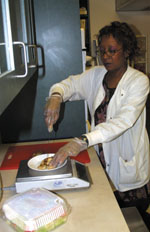Food measured to the gram critical in GCRC
by Heather MurphyPublic Relations
Most people would shrug off the idea of measuring their diet gram by gram.
For Kelley Martin, General Clinical Research Center (GCRC) research nutrition manager, measurement mistakes have the potential to throw off research studies, and for some patients, a gram could be the difference between good health or a health complication.
Martin heads up the GCRC’s metabolic kitchen on the second floor of the Clinical Sciences Building, and although it appears to be a normal kitchen, Martin and her colleagues possess the capabilities to control diets dictated by patient and/or study investigators’ needs.
Martin explained that while the food itself is still comparable to regular food, the difference lies in preparation, weight, and cooking method.
“Some studies require that patients/subjects receive a specified amount of sodium in their diets per meal,” she said. “Investigators could be looking at a variety of things that diet affects, like diabetes, heart disease, or obesity. However, other investigators just need us to control a patient’s caffeine intake. By helping an investigator or patient control diet, we are either eliminating one more variable for that person as it factors into research or patient care, or actually using diet as the interventional outcome.”
 Jacquelyn
Garris, GCRC nutritionist, prepares a portion of grilled chicken for a
patient's meal. Garris and her colleagues must use precise scales and other
methods to prepare meals that conform to study protocols and for patients
who require strict diets.
Jacquelyn
Garris, GCRC nutritionist, prepares a portion of grilled chicken for a
patient's meal. Garris and her colleagues must use precise scales and other
methods to prepare meals that conform to study protocols and for patients
who require strict diets.
While the kitchen’s highest priority goes to study subject patients, overflow from the Medical Center is often covered for those in-house patients in need of a specific diet.
“Unlike dietetic services, we make very specific meals, right down to the tiniest measurement, so when we get a request for a two-gram sodium diet, we have the ability to take it very literally,” Martin said. “All of our canned foods come packed in water, we use a gram scale, and we stay away from serving lots of mixed foods like spaghetti in our nutrient-controlled studies. The GCRC dietary staff is very important, for they are the front-line people who must follow the very detailed and meticulous procedures which are often very different from study to study.”
With all of the recent restructuring of the GCRC space into the Research Support Center (houses the GCRC and a Clinical Research Center for clinical trials) and renovations to the second floor, the new kitchen was added to the floor in April, with a satellite kitchen still intact on the sixth floor of the main hospital.
And while measuring each meal may sound difficult, try getting the patients or subjects to eat it.
“That is definitely the most difficult thing,” Martin said. “We have to work with the patients first and try to address most issues during the consent or screening process. It’s hard enough to get patients to comply with a regular diet plan.”
When outpatient diet plans are involved, Martin and her staff help analyze and measure dietary intake compliance using methods like written food journals, urine analysis, and digital cameras (to take pictures of food before consumption).
An effort to work within a patient's or subject’s diet exists, but the staff still meets resistance. They also must pay close attention to a patient's or subject’s age and investment in the study.
Non-meal services offered by Martin and her colleagues include skin fold measures, diet instruction, data management, some study planning, and journal publication co-authorships.
The Research Support Center also offers bone densitometry services to investigators interested in bone mineral density or body composition results.
As part of a study, a subject may need bone density readings from before and after the investigation.
Headed by Betsy Anderson, X-ray technician, radiology procedures in her unit are conducted via two Hologic DEXA machines that use a fan X-ray beam to image a hip, spine, and forearm for the BMD.
MUSC’s DEXA machine can obtain total body readings for dietary or obesity
studies, and is the only one of its kind in the state that can perform
total body readings on all patients, even those as young as infants.
Catalyst Online is published weekly, updated as
needed and improved from time to time by the MUSC Office of Public Relations
for the faculty, employees and students of the Medical University of South
Carolina. Catalyst Online editor, Kim Draughn, can be reached at 792-4107
or by email, catalyst@musc.edu. Editorial copy can be submitted to Catalyst
Online and to The Catalyst in print by fax, 792-6723, or by email to petersnd@musc.edu
or catalyst@musc.edu. To place an ad in The Catalyst hardcopy, call Community
Press at 849-1778.